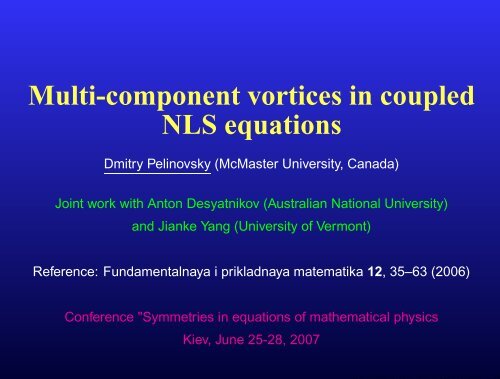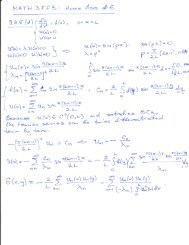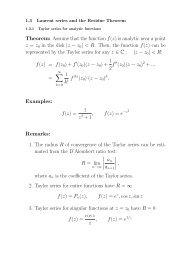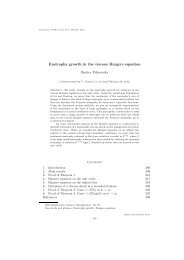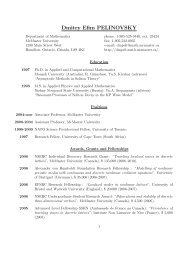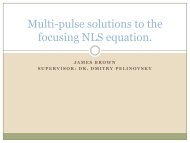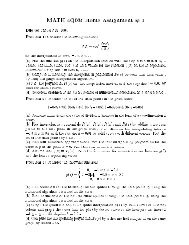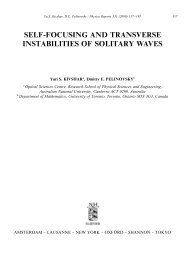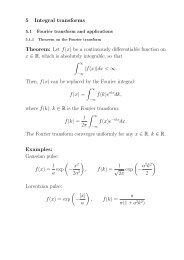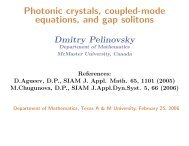Multi-component vortices in coupled NLS equations - Dmitry ...
Multi-component vortices in coupled NLS equations - Dmitry ...
Multi-component vortices in coupled NLS equations - Dmitry ...
Create successful ePaper yourself
Turn your PDF publications into a flip-book with our unique Google optimized e-Paper software.
<strong>Multi</strong>-<strong>component</strong> <strong>vortices</strong> <strong>in</strong> <strong>coupled</strong><strong>NLS</strong> <strong>equations</strong><strong>Dmitry</strong> Pel<strong>in</strong>ovsky (McMaster University, Canada)Jo<strong>in</strong>t work with Anton Desyatnikov (Australian National University)and Jianke Yang (University of Vermont)Reference: Fundamentalnaya i prikladnaya matematika 12, 35–63 (2006)Conference "Symmetries <strong>in</strong> <strong>equations</strong> of mathematical physicsKiev, June 25-28, 2007
Scalar <strong>vortices</strong>Ma<strong>in</strong> model: Focus<strong>in</strong>g two-dimensional <strong>NLS</strong> equationiu t + u xx + u yy + f(|u| 2 )u = 0,where f(s) is C 1 (R + ) and f ′ (s) > 0 on s ∈ R + .Def<strong>in</strong>ition: Vortices are stationary solutions of the formu = R(r)e imθ e iωtwhere (r,θ) are polar coord<strong>in</strong>ates on R 2 , m ∈ N is the vortexcharge and R(r) is a solution of the second-order ODE:R ′′ + 1 r R′ − m2r 2 R − ωR + f(R2 )R = 0,such that R(r) → r |m| as r → 0 and R(r) → e −√ ωr / √ r as r → ∞.
ExamplesSaturable medium with f(s) = s/(1 + s)Cubic-qu<strong>in</strong>tic approximation f(s) = s − s 2Desyatnikov, Kivshar, and Torner, Optical Vortices and VortexSolitons, In: Progress <strong>in</strong> Optics 47, Ed. E. Wolf (2005)
Typical <strong>in</strong>stabilitiesVortices with charges m = 1 and m = 2 are unstable <strong>in</strong> the cubic<strong>NLS</strong> model:Skryab<strong>in</strong> and Firth, Phys. Rev. E 58, 3916 (1998)
Coupled <strong>NLS</strong> <strong>equations</strong>We consider the system of n <strong>coupled</strong> <strong>NLS</strong> <strong>equations</strong>i ˙ψ k + ∆ψ k = W ′ (E)ψ k ,k = 1, 2,...,n,where ψ k : R 2 × R ↦→ C and W : R + ↦→ R + is C 2 -function ofE = ∑ nk=1 |ψ k| 2 . The system is Hamiltonian with∫ [ n∑(( n∑)]H = |∂x ψ k | 2 + |∂ y ψ k | 2) + W |ψ k | 2 dxdyR 2 k=1k=1Vector momentum, angular momentum, and the charges∫Q k = |ψ k | 2 dxdy, k = 1,...,nR 2are basic conserved quantities of the system.
Symplectic symmetriesThe Hamiltonian function is <strong>in</strong>variant with respect to N-parametergroup of rotations <strong>in</strong> the space R 2n or C n × ¯C n , where( )2n (2n)!N = = = n(2n − 1).2 2!(2n − 2)!Let G be a l<strong>in</strong>ear transformation <strong>in</strong> x ∈ R 2n and J be the symplecticmatrix such that ẋ = Jgrad(H(x)). Then, the Hamiltonian systemis <strong>in</strong>variant under the l<strong>in</strong>ear transformation if and only ifJ = GJG TSuch transformations G are called symplectic transformations. IfG = I + g, then gJ + Jg T = 0.
Symmetries of the <strong>coupled</strong> <strong>NLS</strong>Lemma: The group of symplectic rotations <strong>in</strong> R 2n is generated bythe n 2 -parameter matrix( )A Bg = ,−B T Awhere A T = −A and B T = B. Equivalently, the group ofsymplectic rotations <strong>in</strong> C n is generated by g = A − iB.Additional conserved quantities related to the symmetries:∫Q k,m = ψ k ¯ψm dxdy, k = 1,...,n, m = k,...,n,R 2where n quantities are real-valued charges Q k = Q k,k andn(n − 1)/2 quantities Q k,m with m ≠ k are complex-valued.
where (α 1 ,α 2 ) are complex-valued parameters and (θ 1 ,θ 2 ) arereal-valued parameters.Example n = 2Symplectic rotations <strong>in</strong> C 2G 3 =(( )e iθ 10G 1 =0 1)cosθ 3 s<strong>in</strong> θ 3, G 4 =− s<strong>in</strong> θ 3 cosθ 3, G 2 =((1 00 e iθ 2))cosθ 4 i s<strong>in</strong> θ 4,i s<strong>in</strong> θ 4 cos θ 4where θ 1,2,3,4 are def<strong>in</strong>ed on [0, 2π]. If (ψ 1 ,ψ 2 ) is a solution of the<strong>coupled</strong> <strong>NLS</strong> <strong>equations</strong>, then a new solution ( ˜ψ 1 , ˜ψ 2 ) is˜ψ 1 = α 1 e iθ 1ψ 1 + α 2 e iθ 2ψ 2 ,˜ψ 2 = −ᾱ 2 e iθ 1ψ 1 + ᾱ 1 e iθ 2ψ 2 ,
Stationary solutions : classificationConsider the stationary solution <strong>in</strong> the form:ψ k = ϕ k (x)e iω kt ,k = 1,...,n,where ω k is real-valued parameter and ϕ k (x) solves∆ϕ k − ω k ϕ k = W ′ (E)ϕ kFirst Alternative:For any k ≠ m, either (I) ω k = ω m or (II) (ϕ k ,ϕ m ) = 0.Class I conta<strong>in</strong>s a variety of super-symmetric vortex congifurations.Class II conta<strong>in</strong>s a variety of <strong>coupled</strong> states between solitons and<strong>vortices</strong> of different frequencies.
Vortex solutions of class ISeparat<strong>in</strong>g the polar coord<strong>in</strong>ates (r,θ) <strong>in</strong> R 2 :ϕ k = φ k (θ)R k (r),k = 1,...,n,we obta<strong>in</strong> two ODEs:φ ′′k + m 2 kφ k = 0, R ′′k + 1 r R′ k − m2 kr 2 R k = (W ′ (E 0 ) + ω)R k ,where E 0 (r) = ∑ nk=1 R2 k (r)|φ k(θ)| 2 . By the periodicity of φ k (θ),parameter m k is <strong>in</strong>teger (vortex charge).Second Alternative:For any k ≠ m, either (i) m 2 k = m2 m, R k = R m or (ii)∫ ∞0R k (r)R m (r)dr/r = 0, φ k (θ) = e ±im kθ .
Vortex solutions of sub-class I (i)Let m 2 k = m2 and R k = R(r) ∀k, whereThen,R ′′ + 1 r R′ − m2r 2 R = (W ′ (R 2 ) + ω)R.φ k = a k e imθ + b k e −imθ ,k = 1,...,n,subject to the solvability constra<strong>in</strong>t ∑ nk=1 |φ k| 2 = 1, which isequivalent to the normalization <strong>in</strong> C n :‖a‖ 2 + ‖b‖ 2 = 1, (a,b) = 0,where a = (a 1 ,...,a n ) T and b = (b 1 ,...,b n ) T are <strong>in</strong> C n .
Examples for n = 2• If b = 0, then the solution is vortex pair of double charge:ϕ 1 = a 1 R(r)e imθ , ϕ 2 = a 2 R(r)e imθ ,which is equivalent to the scalar vortex a = (1, 0) T bysymplectic rotations• If a = 1 √2(1, 0) T and b = 1 √2(0, 1) T , then the solution is vortexpair of hidden charge:ϕ 1 = 1 √2R(r)e imθ , ϕ 2 = 1 √2R(r)e −imθ .which generates a family with a,b ≠ 0 by symplectic rotations
Examples for n = 2Cubic model(Manakov model)Cubic–quntic model
Vortex solutions of sub-class I (ii)Let φ k (θ) = e ±imkθ with m 2 k be<strong>in</strong>g dist<strong>in</strong>ct for all k. There exists an<strong>in</strong>variant manifold R k (r) ≡ 0 for any k.A hierarchy of vortex states:• Scalar vortex• Two-charge vortexϕ 1 = R(r)e imθ , ϕ k = 0, k = 2,...,n.ϕ 1 = α 1 R 1 (r)e im 1θ , ϕ 2 = α 2 R 2 (r)e im 2θ , ϕ k = 0, k = 3,...n,where R 1,2 (r) solve L m1 R 1 = 0 and L m2 R 2 = 0 withL m = d2dr 2 + 1 rddr − m2r 2 − ω + W ′ (R 2 1 + R 2 2).
Examples for n = 2Cubic (Manakov) system(a) (m 1 ,m 2 ) = (0, 1), (b) (m 1 ,m 2 ) = (0, 2), (c) (m 1 ,m 2 ) = (1, 2).Conjecture from the numerical observations:|m 1 | + n 1 = |m 2 | + n 2 ,where n k is the number of nodes of R k (r) on r > 0.
Symmetries and l<strong>in</strong>earizationStability problem for perturbation vector (u,w) ∈ C 2n is( ) ( ) ( )u I O uH = iλ,v O −I vwhereH = (−∆ + W ′ (E))(I OO I)+ W ′′ (E)(ϕ¯ϕ)· (¯ϕ T ϕ T)and E(x) = ∑ nk=1 |ϕ k(x)| 2 .Remark: The last term <strong>in</strong> H is the outer product, which is a rank-onematrix for any x ∈ R 2 . This can be used for block-diagonalizationand simplification of the stability problem.
Example: <strong>vortices</strong> of sub-class I(ii)For <strong>in</strong>stance, consider a scalar vortex:ϕ k (x) = a k R(r)e imθ , a k ∈ C :n∑k=1|a k | 2 = 1An ortho-normal basis <strong>in</strong> C n : S 1 = {a,c 1 ,c 2 ,...,c n−1 }, where{c j } n−1j=1 spans the orthogonal compliment of a. The decompositionu(x) = α + (x)a +∑n−1j=1γ + j (x)c j, v(x) = α − (x)a +∑n−1j=1γ − j (x)c jblock-diagonalizes H <strong>in</strong>to 2-by-2 <strong>coupled</strong> non-self-adjo<strong>in</strong>t problemfor (α + ,α − ) and pairs of un<strong>coupled</strong> self-adjo<strong>in</strong>t problems for{γ + j ,γ− j }n−1 j=1 .
Example: <strong>vortices</strong> of sub-class I(i)For <strong>in</strong>stance, consider a vortex pair with hidden chargesuch thatϕ k (x) = ( a k e imθ + b k e −imθ) R(r), a k ,b k ∈ C,(a,b) = 0, ‖a‖ 2 = 1 + µ2, ‖b‖ 2 = 1 − µ .2A similar decomposition over an ortho-normal basisS 2 = {a,b,c 1 ,...,c n−2 } ⊂ C n block-diagonalizes H <strong>in</strong>to 4-by-4<strong>coupled</strong> non-self-adjo<strong>in</strong>t problem and pairs of un<strong>coupled</strong>self-adjo<strong>in</strong>t problems.
Example: <strong>in</strong>stabilities of vortex pairs(a) µ = ±1 - vortex of double charge(b) µ = 0 - vortex of hidden charge
Conclusion• Analysis of symplectic rotations and conserved quantities• Classification and simplification of exact vortex solutions andtheir l<strong>in</strong>earizations <strong>in</strong> the system of <strong>coupled</strong> <strong>NLS</strong> <strong>equations</strong>• An algorithm for analysis of a particular family of solutions1. Construct the seed vortex for a given vortex solution2. Study analytically and numerically the associatedl<strong>in</strong>earization problem for the seed vortex3. Rotate the seed vortex and the eigenvectors of the l<strong>in</strong>earizedproblem with the same group of symplectic rotations toobta<strong>in</strong> relevant results for the given vortex.• Nonl<strong>in</strong>ear dynamics of solutions along the family of symplecticrotations is not yet well understood.


